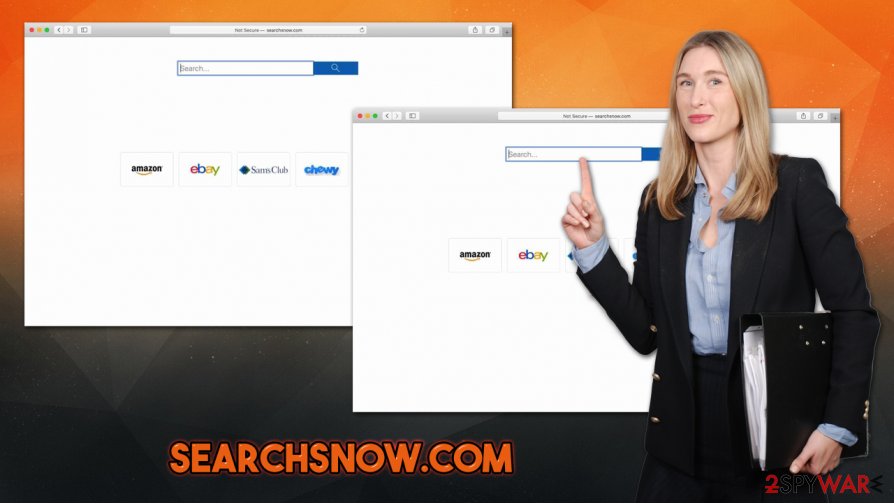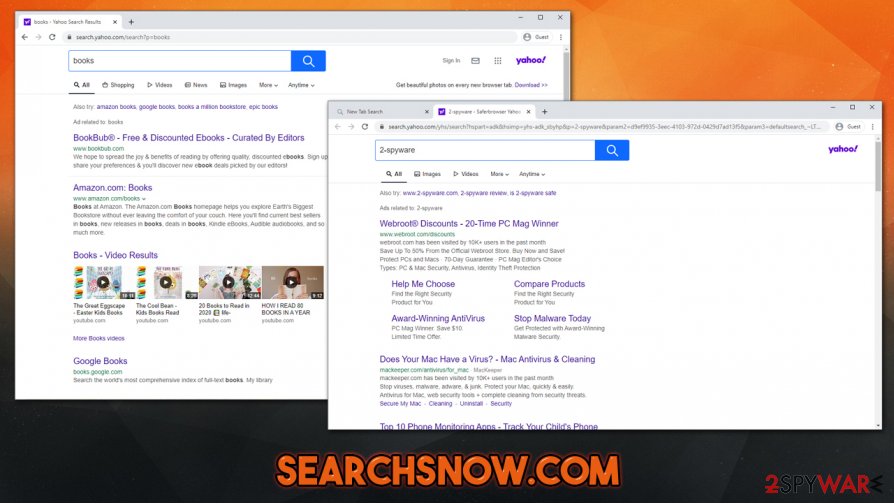Searchsnow.com (Simple Removal Guide) - Free Instructions
Searchsnow.com Removal Guide
What is Searchsnow.com?
Searchsnow.com is a browser hijacker that tries to imitate a legitimate search engine

Searchsnow.com is a web address that users might notice as their homepage for Google Chrome, Mozilla Firefox, Safari, or another web browser. Unexpected changes to the new tab address, homepage, and the search engine typically indicate that a type of a potentially unwanted program – browser hijacker – has been installed on your computer. While the unwanted app can be found on different operating systems, Mac users are the ones who complained about the infection the most.
Searchsnow.com hijack can become visible right after its infiltration, which typically occurs behind users' backs, as a deceptive distribution technique called bundling is used by the PUP authors. Besides visible changes such as homepage URL modification, the app is also set up to gather user-related web browsing information without adequately informing the affected.
| Name | Searchsnow.com |
| Type | Browser hijacker, potentially unwanted application |
| Affected platforms | macOS, Windows |
| Infiltration | Most browser hijackers are distributed within software bundle packages downloaded from third-party sites, although users can sometimes install them deliberately without knowing much about the operation principles of such apps |
| Symptoms | Unknown browser extensions or apps installed on the computer/browser; homepage and new tab URL is set to searchsnow.com; all searches are redirected to Yahoo or another search provider; search results are filled with sponsored links; overall increased amount of advertisements while browsing |
| Elimination | You can uninstall a potentially unwanted program by following manual instructions below or by scanning the device with anti-malware software |
| Optional steps | To ensure that your computer is ad-free and does not experience any problems in the future, we suggest also resetting the web browser and scanning the device with a repair tool FortectIntego for best results |
As soon as the so-called Searchsnow.com virus is installed on the system, it will immediately change the homepage of the web browser to hxxps://searchsnow.com, which visually imitates the look of Google.com – a search engine that over 60% of users choose as their main search engine. Additionally, users will also notice that the homepage is injected with links to various websites, including Amazon, eBay, Facebook, or others.
This way, the developers of the hijacker are trying to make users believe that its presence on the machine useful, and that Searchsnow.com removal should not be performed. However, many security experts, including those from novirus.uk,[1] recommend doing a complete opposite due to various security and privacy issues.
Each time users affected by Searchsnow.com hijacker attempt to use the customized search engine, they will notice that all their searchers are redirected to one of the following search providers:
- Yahoo;
- Google;
- Bing;
- Safe Finder, or other.
Regardless of which search provider is used, users most commonly will see an extensive amount of ads/sponsored links at the top of the search results. Unfortunately, such ads are shown in a way that inexperienced PC or Mac users would not notice the deception and click on a sponsored link instead of the organic[2] one which can only be found after scrolling down to the bottom of the page.
This way, the developers of Searchsnow.com ensure that maximum profits are retained due to pay-per-click monetization methods. However, those who have their browsers infected will suffer from intrusive ads regardless if they want to see them or not. Besides, some ads could potentially be malicious and redirect users to scam or similar sites.

Another reason to remove Searchsnow.com is information tracking practices. While it might not be noticeable, potentially unwanted programs almost always use cookies, web beacons, scripts, and other forms of tracking technologies to collect information about users who have the PUP installed. While in most cases, only anonymous data is collected, some hijackers collect personal data as well, which includes your IP, search queries, and much more.
All in all, we suggest you uninstall Searchsnow.com hijacker from your system immediately. You can use our manual guide below or employ automatic solutions for the job. Note that not all security applications recognize browser hijackers, so manual termination might be your only option.
However, in case there is malware on your system, you should employ reputable antivirus software. If something is found, we also recommend performing a full browser reset and using repair tools such as FortectIntego to fix virus damage of the OS.
Prevent browser and computer clutter: avoid potentially unwanted programs
Potentially unwanted programs are not considered to be major security threats, as they rarely modify crucial Windows or Mac system files in order to gain benefits in some way. For example, malware authors typically use infected computers as tools for information harvesting, botnet[3] functionality, other malware proliferation, and much more. Browser hijackers simply cannot be used for such purposes; hence they are not considered malware. Despite this, some adware apps perform actions that resemble malware operation much more than it should.
Another reason why PUPs are not considered malware is their infiltration techniques. Malware is usually installed via sophisticated techniques, such as spam email macros, drive-by downloads, software cracks, and similar. In contrary, adware or browse hijackers are typically spread via software bundles, where several apps are installed at once. Thus, being careful during the installation process of freeware can prevent unintentional infiltration of PUPs and even malware.
Thus, always pick reputable download sources, opt for Advanced/Custom settings instead of Recommended/Quick ones, and never rush the installation process by pressing “Next” several times. Besides, installing a powerful anti-malware program will point you at PUPs before they manage to access your computer.

Searchsnow.com removal guide
If you noticed that your homepage and other browser settings on the Google Chrome, Mozilla Firefox, Safari, or another web browser changed unexpectedly, you should immediately proceed with Searchsnow.com removal. While browser hijackers are considered more a nuisance rather than a security threat, keep in mind that you provide access of your information to the unnecessary party that could misuse it at any time (for example, sell it to a third-party so you will receive more offers and similar ads when browsing the web).
If you want to remove Searchsnow.com quickly, you can employ anti-malware software for the purpose. It can scan the device in just a few minutes and find all the unwanted or malicious files immediately. However, not all browser hijackers can be detected by all AVs, so you should keep that in mind. In case a reputable security tool is not detecting the hijacker, you can follow the manual elimination guide we provide below. You can also reset your web browsers if ads and browser changes do not disappear for good.
You may remove virus damage with a help of FortectIntego. SpyHunter 5Combo Cleaner and Malwarebytes are recommended to detect potentially unwanted programs and viruses with all their files and registry entries that are related to them.
Getting rid of Searchsnow.com. Follow these steps
Uninstall from Windows
To uninstall potentially unwanted programs from Windows systems, you should perform the following steps:
Instructions for Windows 10/8 machines:
- Enter Control Panel into Windows search box and hit Enter or click on the search result.
- Under Programs, select Uninstall a program.

- From the list, find the entry of the suspicious program.
- Right-click on the application and select Uninstall.
- If User Account Control shows up, click Yes.
- Wait till uninstallation process is complete and click OK.

If you are Windows 7/XP user, proceed with the following instructions:
- Click on Windows Start > Control Panel located on the right pane (if you are Windows XP user, click on Add/Remove Programs).
- In Control Panel, select Programs > Uninstall a program.

- Pick the unwanted application by clicking on it once.
- At the top, click Uninstall/Change.
- In the confirmation prompt, pick Yes.
- Click OK once the removal process is finished.
Delete from macOS
macOS users can also fall victim to browser hijackers, PUPs, or malware. If you suspect that your Mac is infected, proceed with the following instructions:
Remove items from Applications folder:
- From the menu bar, select Go > Applications.
- In the Applications folder, look for all related entries.
- Click on the app and drag it to Trash (or right-click and pick Move to Trash)

To fully remove an unwanted app, you need to access Application Support, LaunchAgents, and LaunchDaemons folders and delete relevant files:
- Select Go > Go to Folder.
- Enter /Library/Application Support and click Go or press Enter.
- In the Application Support folder, look for any dubious entries and then delete them.
- Now enter /Library/LaunchAgents and /Library/LaunchDaemons folders the same way and terminate all the related .plist files.

Remove from Microsoft Edge
Delete unwanted extensions from MS Edge:
- Select Menu (three horizontal dots at the top-right of the browser window) and pick Extensions.
- From the list, pick the extension and click on the Gear icon.
- Click on Uninstall at the bottom.

Clear cookies and other browser data:
- Click on the Menu (three horizontal dots at the top-right of the browser window) and select Privacy & security.
- Under Clear browsing data, pick Choose what to clear.
- Select everything (apart from passwords, although you might want to include Media licenses as well, if applicable) and click on Clear.

Restore new tab and homepage settings:
- Click the menu icon and choose Settings.
- Then find On startup section.
- Click Disable if you found any suspicious domain.
Reset MS Edge if the above steps did not work:
- Press on Ctrl + Shift + Esc to open Task Manager.
- Click on More details arrow at the bottom of the window.
- Select Details tab.
- Now scroll down and locate every entry with Microsoft Edge name in it. Right-click on each of them and select End Task to stop MS Edge from running.

If this solution failed to help you, you need to use an advanced Edge reset method. Note that you need to backup your data before proceeding.
- Find the following folder on your computer: C:\\Users\\%username%\\AppData\\Local\\Packages\\Microsoft.MicrosoftEdge_8wekyb3d8bbwe.
- Press Ctrl + A on your keyboard to select all folders.
- Right-click on them and pick Delete

- Now right-click on the Start button and pick Windows PowerShell (Admin).
- When the new window opens, copy and paste the following command, and then press Enter:
Get-AppXPackage -AllUsers -Name Microsoft.MicrosoftEdge | Foreach {Add-AppxPackage -DisableDevelopmentMode -Register “$($_.InstallLocation)\\AppXManifest.xml” -Verbose

Instructions for Chromium-based Edge
Delete extensions from MS Edge (Chromium):
- Open Edge and click select Settings > Extensions.
- Delete unwanted extensions by clicking Remove.

Clear cache and site data:
- Click on Menu and go to Settings.
- Select Privacy, search and services.
- Under Clear browsing data, pick Choose what to clear.
- Under Time range, pick All time.
- Select Clear now.

Reset Chromium-based MS Edge:
- Click on Menu and select Settings.
- On the left side, pick Reset settings.
- Select Restore settings to their default values.
- Confirm with Reset.

Remove from Mozilla Firefox (FF)
Remove dangerous extensions:
- Open Mozilla Firefox browser and click on the Menu (three horizontal lines at the top-right of the window).
- Select Add-ons.
- In here, select unwanted plugin and click Remove.

Reset the homepage:
- Click three horizontal lines at the top right corner to open the menu.
- Choose Options.
- Under Home options, enter your preferred site that will open every time you newly open the Mozilla Firefox.
Clear cookies and site data:
- Click Menu and pick Settings.
- Go to Privacy & Security section.
- Scroll down to locate Cookies and Site Data.
- Click on Clear Data…
- Select Cookies and Site Data, as well as Cached Web Content and press Clear.

Reset Mozilla Firefox
If clearing the browser as explained above did not help, reset Mozilla Firefox:
- Open Mozilla Firefox browser and click the Menu.
- Go to Help and then choose Troubleshooting Information.

- Under Give Firefox a tune up section, click on Refresh Firefox…
- Once the pop-up shows up, confirm the action by pressing on Refresh Firefox.

Remove from Google Chrome
Browser hijackers such as Searchsnow.com can change browser settings without user permission. They might remain on the web browser even after PUP elimination. Thus, if you can't get rid of ads or other unwanted browser activity, reset Google Chrome:
Delete malicious extensions from Google Chrome:
- Open Google Chrome, click on the Menu (three vertical dots at the top-right corner) and select More tools > Extensions.
- In the newly opened window, you will see all the installed extensions. Uninstall all the suspicious plugins that might be related to the unwanted program by clicking Remove.

Clear cache and web data from Chrome:
- Click on Menu and pick Settings.
- Under Privacy and security, select Clear browsing data.
- Select Browsing history, Cookies and other site data, as well as Cached images and files.
- Click Clear data.

Change your homepage:
- Click menu and choose Settings.
- Look for a suspicious site in the On startup section.
- Click on Open a specific or set of pages and click on three dots to find the Remove option.
Reset Google Chrome:
If the previous methods did not help you, reset Google Chrome to eliminate all the unwanted components:
- Click on Menu and select Settings.
- In the Settings, scroll down and click Advanced.
- Scroll down and locate Reset and clean up section.
- Now click Restore settings to their original defaults.
- Confirm with Reset settings.

Delete from Safari
Remove unwanted extensions from Safari:
- Click Safari > Preferences…
- In the new window, pick Extensions.
- Select the unwanted extension and select Uninstall.

Clear cookies and other website data from Safari:
- Click Safari > Clear History…
- From the drop-down menu under Clear, pick all history.
- Confirm with Clear History.

Reset Safari if the above-mentioned steps did not help you:
- Click Safari > Preferences…
- Go to Advanced tab.
- Tick the Show Develop menu in menu bar.
- From the menu bar, click Develop, and then select Empty Caches.

After uninstalling this potentially unwanted program (PUP) and fixing each of your web browsers, we recommend you to scan your PC system with a reputable anti-spyware. This will help you to get rid of Searchsnow.com registry traces and will also identify related parasites or possible malware infections on your computer. For that you can use our top-rated malware remover: FortectIntego, SpyHunter 5Combo Cleaner or Malwarebytes.
How to prevent from getting browser hijacker
Stream videos without limitations, no matter where you are
There are multiple parties that could find out almost anything about you by checking your online activity. While this is highly unlikely, advertisers and tech companies are constantly tracking you online. The first step to privacy should be a secure browser that focuses on tracker reduction to a minimum.
Even if you employ a secure browser, you will not be able to access websites that are restricted due to local government laws or other reasons. In other words, you may not be able to stream Disney+ or US-based Netflix in some countries. To bypass these restrictions, you can employ a powerful Private Internet Access VPN, which provides dedicated servers for torrenting and streaming, not slowing you down in the process.
Data backups are important – recover your lost files
Ransomware is one of the biggest threats to personal data. Once it is executed on a machine, it launches a sophisticated encryption algorithm that locks all your files, although it does not destroy them. The most common misconception is that anti-malware software can return files to their previous states. This is not true, however, and data remains locked after the malicious payload is deleted.
While regular data backups are the only secure method to recover your files after a ransomware attack, tools such as Data Recovery Pro can also be effective and restore at least some of your lost data.























